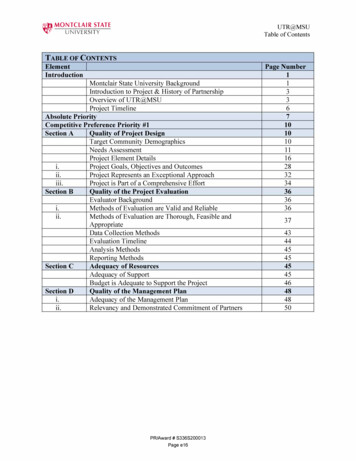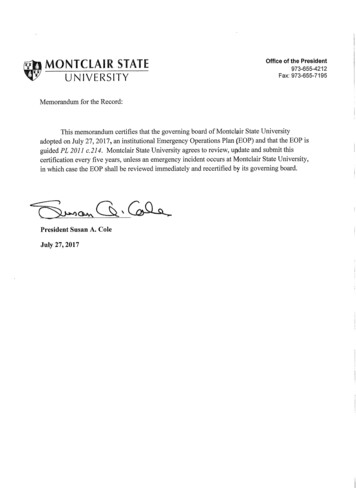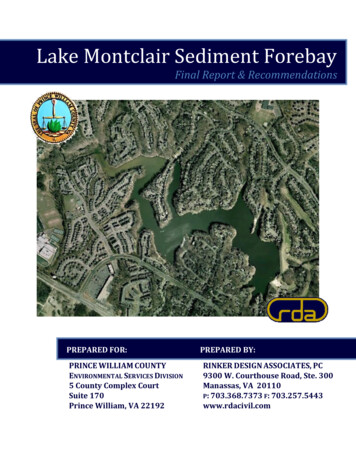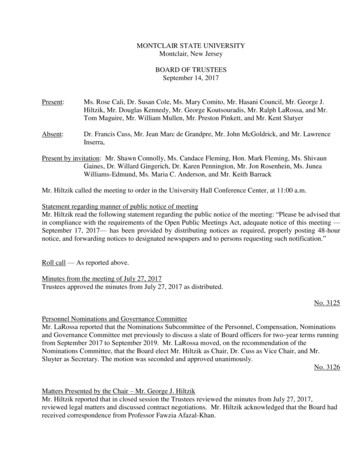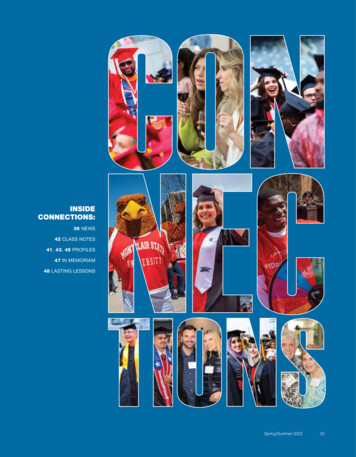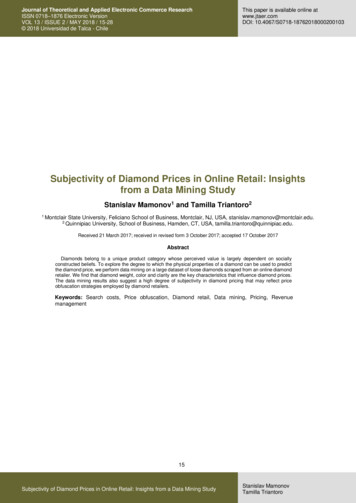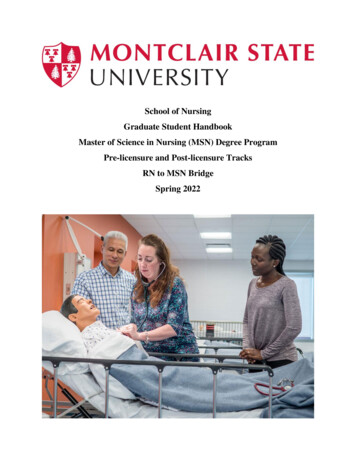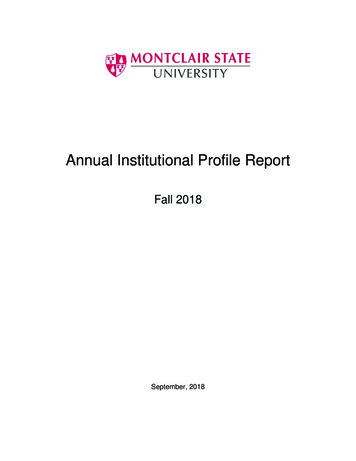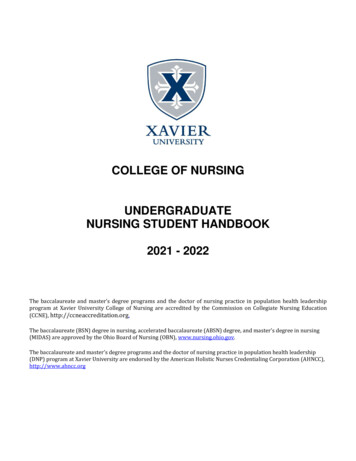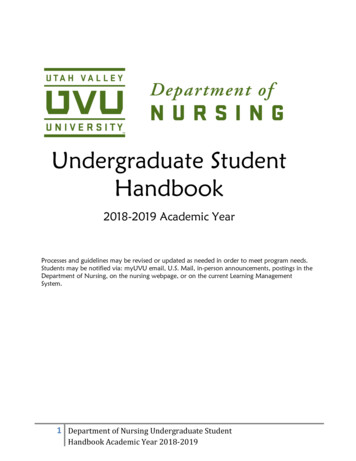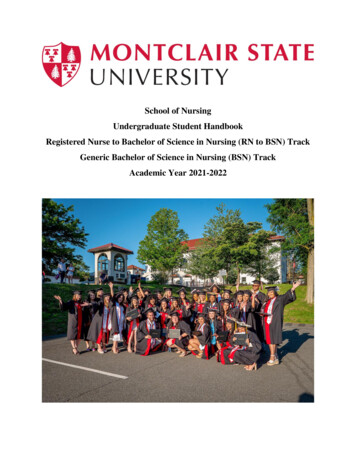
Transcription
School of NursingUndergraduate Student HandbookRegistered Nurse to Bachelor of Science in Nursing (RN to BSN) TrackGeneric Bachelor of Science in Nursing (BSN) TrackAcademic Year 2021-2022
School of Nursing – Undergraduate Student Handbook (2021-2022)Table of ContentsIntroductionMontclair State UniversityMontclair State University ResourcesHistory of the School of NursingSchool of Nursing DirectoryStatement of PhilosophyOrganizing FrameworkMission, Vision, and ValuesShared GovernanceThe Bachelor of Science in Nursing (BSN) Degree ProgramGeneric BSN Track EligibilityOnline RN to BSN Track EligibilityMaster of Science in Nursing (MSN) EligibilityBSN Program GoalsBSN Student OutcomesExpected Program OutcomesCommission on Collegiate Nursing Education (CCNE) Accreditation StatusNew Jersey Board of Nursing StatementDegree and Program RequirementsGeneric Bachelor of Science in Nursing (BSN) Sample CurriculumOnline RN to BSN CurriculumNursing Major Course DescriptionsCourse DeliveryTransfer of CreditsOrientationCommunicationEmergency Alert SystemInclement Weather ProceduresAcademic AdvisementGrading PoliciesAcademic ProgressionProgressionRetention and DismissalAcademic ProbationAcademic SuspensionSeparable vs. Inseparable OffensesAccommodations Due to DisabilityClinical Practicum ParticipationRequirements in Preparation for the Clinical PracticumCriminal Background CheckProfessional Liability (Malpractice) InsuranceAmerican Heart Association CPR CertificationHealth and Immunization Information“Equivocal” or “Not Immune’ ResultsCOVID-19 VaccinationPersonal Health InsuranceSubmission of 22The Undergraduate Student Handbook was revised and approved on 1/12/2022.
School of Nursing – Undergraduate Student Handbook (2021-2022)Approved Attire for Clinical Practicum (Generic BSN Track)Approved Attire for Clinical Practicum (RN to BSN Track)Professional Behavior at the Clinical Site/SettingCompliance with HIPAAProper Use of Social Media in Compliance with HIPAABlood Borne Pathogen Exposure in the Clinical SettingUnprofessional Conduct and/or Professional MisconductClinical EvaluationClinical Probation, Failure, and DismissalClinical ProbationClinical Failure/DismissalScheduling the Clinical PracticumTransportation to the Clinical SitesMakeup of Missed Clinical ExperiencesSelected Policies and Procedures of Montclair State UniversitySchool of Nursing Student Complaint ProcedureUniversity Grievance ProcedureGoals and Objectives of the Grievance CommitteeInformal Resolution ProcedureFormal Resolution ProcedureGrievance Committee ProcedureAppeal ProcessImmunization Requirements for Students at Montclair State UniversityAppendicesAppendix A: National Student Nurses’ Association, Inc. – Code of Academic and Clinical ConductAppendix B: American Nurses Association (ANA) Code of EthicsAppendix C: International Council of Nurses (ICN) Code of EthicsAppendix D: Montclair State University School of Nursing Handbook Attestation FormAppendix E: Math Exam 423The Undergraduate Student Handbook was revised and approved on 1/12/2022.
School of Nursing – Undergraduate Student Handbook (2021-2022)IntroductionThe School of Nursing Faculty and Administration are pleased you selected Montclair State Universityfor your nursing education. This handbook is designed to provide useful information about the Bachelorof Science in Nursing (BSN) degree program as a supplement to the information provided in theMontclair State University Undergraduate Student Handbook. The Undergraduate Student Handbook canbe accessed on the website of Student Services. If you have general questions about the program, pleasecontact your Academic Advisor first, and then the appropriate Program Director. For course specificinformation, contact the instructor.As we begin the current academic year, it is important all members of the Montclair State Universitycommunity follow procedures designed to mitigate the spread of the Sars-CoV2 virus. It is anticipatedthat guidance will evolve in response to new knowledge and circumstances. The School of Nursingwebsite will provide information specific to the nursing program and will direct you to Universityresources.Montclair State UniversityMontclair State University is New Jersey’s second largest university with an enrollment of 21,000graduate and undergraduate students. For more than 110 years, Montclair State University has changed inresponse to the evolving higher education needs of New Jersey, transforming itself from a TeachersCollege into a leading national research doctoral institution offering more than 300 academically rigorousdoctoral, master’s and baccalaureate programs. Forbes has described Montclair State University as “NewJersey’s best public university.” U.S. News & World Report ranked it among the nation’s top 200universities.Designations as an R2-Doctoral University – High Research Activity by the national CarnegieClassification of Institutions of Higher Learning and as a New Jersey State Public Research University,recognize both Montclair State University’s growing number of doctoral students engaged in researchfields as well as its ongoing success in attracting significant funding from diverse sources, includingawards from as the National Science Foundation; the United States Department of Defense; the UnitedStates Department of Education; and the State of New Jersey.Montclair State University is proud of its long tradition of championing diversity. More than half of itsstudents are minority group members and it is a U.S. Department of Education-designated HispanicServing Institution (HSI).Montclair State University’s uncompromising insistence on excellence is evident in stellar, top-rankedacademic programs in fields of study ranging from accounting to teacher education that prepare graduatesfor career success in everything from filmmaking and finance to nursing and physics.4The Undergraduate Student Handbook was revised and approved on 1/12/2022.
School of Nursing – Undergraduate Student Handbook (2021-2022)Montclair State University ResourcesCampus LocationMontclair is a township in Essex County, New Jersey, located only 12 miles from New York City.Montclair’s proximity to NYC makes it an attractive suburb for commuters, and several publictransportation options make the town (and the campus) accessible for students, whether living on or offcampus in Montclair or elsewhere in New Jersey or New York. Several NJ Transit bus lines serveMontclair and have stops on the campus. A NJ Transit commuter rail line (the Montclair-Boonton Line)runs through Montclair and serves the campus via two (2) campus train stations, Montclair Heights (onNormal Avenue) and Montclair State University (on Clove Road). Montclair is also 13 miles fromNewark Liberty International Airport.See University Facilities for more information about transportation options in Montclair.In addition, Montclair is noted for its historic architecture and parks, as well as its lively arts, shopping,and restaurant scene in both downtown Montclair and in a smaller area north of downtown known asUpper Montclair.Student HousingCampus housing is available for students. Further information can be found by visiting the website of theOffice of Residence Life.Student Workspaces and Computing FacilitiesStudents may access the internet on campus by connecting to the MSU-Secure wireless network withtheir Net ID and password. Instructions for accessing the network are located on the InformationTechnology Division website. Various workspaces for students are located in many campus buildings.Popular spots for students to work with their own laptops are located in the School of Nursing, FelicianoSchool of Business, University Hall, and Dickson Hall. Computer lab facilities for student use are alsoavailable on the fifth floor of University Hall.Printing and CopyingInformation about campus printing services, including locations with printing capabilities, can be foundby visiting the website of the Information Technology Division.Technology SupportStudents may request assistance with Montclair State University owned computers by contacting theUniversity Help Desk at 973-655-7971 or by visiting the Student Services page of the InformationTechnology Division website.Shuttle Service on CampusVarious shuttles provide free transportation around campus for students. Shuttles stop at campus locationsconvenient for students, including University Hall. Lot 60, Red Hawk Parking Deck, CarParc DiemGarage, and the Montclair State University NJ Transit Train Station. Further information about shuttleservices can be found by visiting the website of University Facilities.Student ServicesMontclair State University provides academic and student-centered services to support and enhancestudents’ experiences during their enrollment. Some services used by our students are described below:5The Undergraduate Student Handbook was revised and approved on 1/12/2022.
School of Nursing – Undergraduate Student Handbook (2021-2022)Center for Career Services – This center provides resources and support designed to advance students’career development through the job search process. They also provide assistance with career advising,networking, job search strategies, application materials, and interviewing. More information can be foundon the Career Services website.Center for Writing Excellence – This center offers individual and group conferences with experiencedwriting consultants to assist with all stages of the writing process. They also serve as a resource forpreparation of curriculum vitae and cover letters. More information can be found on the Center forWriting Excellence website.Disability Resource Center – This center coordinates academic support and accommodations, incompliance with Section 504 of the Rehabilitation Act of 1973, to provide access to academic programsfor students with physical, sensory, learning, psychological, neurological, and chronic medicaldisabilities. More information can be found on the Disability Resource Center website.Financial InformationInformation about tuition and fees for students can be found on the website of Student Accounts.Disability Resource CenterEach semester, students are responsible for requesting a memorandum from the Office for Students withDisabilities to notify faculty of their requested individual accommodations. This should be done at thestart of each semester on the Disability Resource Center website.Montclair State University is committed to meeting students’ needs. The following resources are availableto students in addition to School of Nursing faculty support. Each link will lead you to the respectivewebsite to learn more information about each resource. Office of the Dean of StudentsAcademic Honesty and IntegrityStudents Reflections on Moral Conflicts in CollegeAcademic Retention StandardsAcademic AdvisingCenter for Student Involvement (CSI)Center for Writing Excellence (CWE)Commuter LifeCounseling and Psychological Services (CAPS)Disability Resource Center (DRC)Financial Aid OfficeGreek LifeLeadership Development ProgramsLGBTQ CenterSexual Assault Response Team (SART)Student AccountsStudent ConductStudent Recreation Center (Rec Center)Tutoring ServicesUniversity CollegeWomen’s Center6The Undergraduate Student Handbook was revised and approved on 1/12/2022.
School of Nursing – Undergraduate Student Handbook (2021-2022)History of the School of NursingIn June 2015, the Montclair State University Board of Trustees approved the establishment of a School ofNursing. The Registered Nurse (RN) to Bachelor of Science in Nursing (BSN) degree track was approvedby the President’s Executive Council of New Jersey in November 2015. The inaugural RN to BSN classentered Montclair State University in fall 2016.In June 2017, the New Jersey State Board of Nursing approved the four-year generic Bachelor of Sciencein Nursing (BSN) track. Upon successful completion of the program, students are qualified to sit for theNCLEX-RN examination. In fall 2017, the first class commenced with 50 freshmen. Students from thisinaugural class graduated in spring 2021. The program continues to build incrementally each year.In fall 2018, students began enrolling in the post-licensure Master of Science in Nursing (MSN) degreeprogram, which offers three (3) specialty concentrations – Education, Administration, and ClinicalResearch. This program offers two (2) tracks to the MSN. Registered nurses with BSN degrees directlyenter this 35-credit online MSN degree program. Registered nurses with baccalaureate degrees in nonnursing disciplines are accepted into the RN to MSN Bridge Program. Upon successful completion of the13-credit bridge, students are admitted to the MSN program.In fall 2020, students enrolled in the pre-licensure generic Master of Science in Nursing (MSN) degreeprogram, which specializes in Care Coordination and Transition Management. This full-time programprepares persons with baccalaureate degrees in disciplines other than nursing, who have successfullycompleted specific pre-requisite courses, the opportunity to enter the nursing profession. Upon successfulcompletion of the program, students are qualified to sit for the NCLEX-RN examination.7The Undergraduate Student Handbook was revised and approved on 1/12/2022.
School of Nursing – Undergraduate Student Handbook (2021-2022)School of Nursing DirectoryNameTitleE.MailPhoneAdministration & Professional StaffJanice Smolowitz, PhD,Ed.D., DNP, RN, ANPBCJoan Valas, PhD, RN,ACNP-BCElizabeth Zweighaft,Ed.D., RNDean and ProfessorProfessor and Directorof Post-licensureNursing ProgramsAssociate Professor andDirector of Prelicensure air.edu973-655-3718Eileen Kearney, MSAssociate her Curran,MBAWeb 3John GurriellSimulation r.edu973-655-3693Evelyn RogersCarolina SanchezAdministrativeAssistant for Postlicensure ProgramsAdministrativeAssistant for Prelicensure ProgramsFacultyNastassia Davis, DNP,RN-MNN, IBCLCAssistant Professordavisn@montclair.edu973-655-3631Mary Beth Duffy,DNP, RN, APNAssociate Professorduffym@montclair.edu973-655-3628Yanick Joseph, Ed.D.,RNAssistant Professorjosephy@montclair.edu973-655-3641Sarah Kelly, PhD, RNAssociate Professorkellys@montclair.edu973-655-3697Rachel Lyons, DNP,RN, CPNP-PC/ACAssociate Professorlyonsr@montclair.edu973-655-36578The Undergraduate Student Handbook was revised and approved on 1/12/2022.
School of Nursing – Undergraduate Student Handbook (2021-2022)Patricia McGaughey,PhD, CNM, MSN, RNAssistant ney Reinisch,DNP, RN, APN-CAssociate Professorreinischc@montclair.edu973-655-3717Rosita Rodriguez,DNP, RN-BC,AGPCNP-BC, FNPBC, WHNP- BC, CDE,CNEAssociate cal SpecialistsElsie Alabi-Gonzalez,MSN, RN, CNEcl,MEDSURG-BC,PCCNAnja L. Deitmer, MSN,BSN-RN, CCM,BS/BAClinical inical Specialistdeitmera@montclair.edu973-655-3760Sherod Nicholas, MSNED, RNClinical Specialistnicholass@montclair.edu-Holly Hutchinson,MSN, RN CHSEClinical riet Sarkodie, MSN,RN-BC, NPD-BCClinical Specialistsarkodieh@montclair.edu973-655-37799The Undergraduate Student Handbook was revised and approved on 1/12/2022.
School of Nursing – Undergraduate Student Handbook (2021-2022)Statement of PhilosophyThe School of Nursing Statement of Philosophy describes the faculty’s beliefs about nursing as adiscipline. The term discipline depicts nursing’s foundational worldview, values, ethics, traditions,theories, and principles, serving as an internal locus that guides education, research, and practice. Thefaculty believe nursing is grounded in human caring science, which focuses on caring, being whole, andbeing healed in specific contexts and relationships (Hills, & Watson, 2011). The faculty include thefollowing concepts in their statement of philosophy: caring, communication, environment, healing, health,health beliefs, humans, nursing, shared decision-making, social-cultural world, teaching learning process,and trans-professional collaboration.CaringWhile there are many caring theories, Swanson’s theory of caring (1991, 1993) has been selected as thebasis for teaching-learning and assessing faculty and student attributes for the domain of caring. Swanson(1991, 1993) defines caring as, “A nurturing way of relating to a valued other person, towards whom onefeels a personal sense of commitment and responsibility” (Swanson, 1991, p. 165). Nurses enter caringrelationships with one or more humans, families, and communities. Swanson describes five (5) processesthat are characteristic of a caring relationship: knowing, being with, doing for, enabling, and maintainingbelief. Knowing occurs as the nurse attempts to understand an occurrence as it has meaning in the life ofthe person (Swanson, 1998). The experience of the person serves as the starting point for understanding.The nurse carefully listens to the person without taking anything for granted. The nurse and person areboth actively engaged in this process (Swanson, 1991; 1993).Being with describes being emotionally present for the other person. The nurse shares emotions but doesnot burden the person (Swanson, 1991; 1993). The nurse understands and values the importance of theperson’s feelings. By being emotionally open to the person’s reality, there is an increased possibility thatthe nurse will be able to understand the person’s situation.Doing for describes actions the person would normally perform for him/herself (Swanson, 1991; 1993).The nurse performs these actions to protect and preserve that person’s dignity. The nurse competently andskillfully performs these actions to help, protect, increase comfort, and anticipate the person’s needs.Enabling is facilitating the person’s passage through life transitions and/or unfamiliar events, whichfacilitate that person’s ability to grow, heal and or practice self-care (Swanson, 1991; 1993). The processof enabling is demonstrated by the nurse when he or she focuses on the event, informs, explains, supports,allows for, validates feelings, generates alternatives, reflects on options, and provides feedback.Maintaining belief is described as sustained faith in the capacity of the person’s ability to endure andovercome events or transitions and face a future with meaning. The nurse demonstrates maintaining beliefwhen he or she believes in the other person’s abilities, holds that person in high esteem, and maintains ahope-filled attitude to help the person find meaning. Nurses inspire confidence by offering realisticoptimism and staying with the person, even in hopeless situations. The five (5) caring processes areinterrelated and overlap.CommunicationCommunication is a complex process that involves giving, receiving, exchanging, or transferring abstractthoughts, ideas, information, signals or messages using various media to persuade, inform, share and orexpress emotion. The communication process involves conscious and or unconscious role negotiation.10The Undergraduate Student Handbook was revised and approved on 1/12/2022.
School of Nursing – Undergraduate Student Handbook (2021-2022)Effective communication involves minimizing misunderstanding and overcoming barriers at each stage ofthe process. Effective communicators seek feedback from recipients to ensure the message is understoodand attempt to correct any confusion as quickly as possible. Receivers use clarification and reflection toensure the message has been understood.EnvironmentHealth is grounded in and sustained by the environment. Social, economic, and political factors that shapeand modify the environment influence the health of society on a global level. Responsible citizenshiprequires that nurses’ worldview include the health of humanity and state of the planet at the present timeand for future generations. An ecocentric approach, embedded in holistic metaphysics, describes theenvironment as whole, interconnected, and alive. Using an ecocentric paradigm, nurses consider theplanetary environment, share their expertise, and advocate for responsible use of resources.HealingHealing integrates physical, social, psychological, cultural, and spiritual aspects of being. Healing restoresunity and balance. Healing transcends western medicine’s approach to curing and treating disease.Healing is focused on humans as a whole in the context of their environment.HealthHealth is one dimension of human existence. It is not the absence of disease. Health and disease coexist(Hills & Watson, 2011). Health is a state of equilibrium that humans establish within themselves andbetween themselves and their social and physical environments. Humans with medical conditions can beconsidered healthy based on their ability to establish internal equilibrium despite the presence of illness.The attainment of the highest possible level of health for all persons is a goal that requires action by manysectors of society. Health is a basic human right (International Conference on Primary Health Care, 1978).Health BeliefsHealth is subjectively defined by humans within the context of their own experiences. Health beliefsinclude humans’ internal experiences and external expressions of their experiences. Health beliefsincorporate spiritual and physical assumptions. Humans, who express their health beliefs, must beauthentically heard as they search for their own best solutions and listen to their inner wisdom.HumansHumans are unitary beings who experience the world as a whole and create meaning based on theirexperiences. Situated in time and space, humans’ biological, psychological, social, spiritual, and culturalattributes influence their development. They have rights and inherent dignity that must be respected.Humans are best understood within their own specific contexts. Humans are able to identify their ownneeds, address their own problems, and know what actions will best serve them in specific situations.Humans are constantly evolving. Learning occurs at a pace specific to each person, family, and orcommunity.NursingThe verb nursing holds different meanings depending upon humans’ world view. For purposes of thisdiscussion of the Generic BSN Track, nursing refers to the role and responsibilities of RNs who havecompleted a recognized generalist nursing program of education leading to conferral of the BSN degreeand are authorized by the appropriate regulatory authority to practice nursing. According to New Jerseystatute, registered professional nurses diagnose and treat human responses to actual or potential physical11The Undergraduate Student Handbook was revised and approved on 1/12/2022.
School of Nursing – Undergraduate Student Handbook (2021-2022)and emotional health problems, through case finding, health teaching, health counseling, and provision ofcare that supports or restores life and wellbeing.Nursing DiagnosisNursing diagnosis refers to the identification of and discrimination between physical and psychosocialsigns and symptoms. Treatment refers to nurses’ selection and performance of those therapeuticinterventions, which are essential to the nursing regimen. Human responses are the signs, symptoms, andprocesses that identify the person’s health need related to an actual or potential health problem.Registered nurses implement medical regimens as prescribed by licensed or legally authorized providers.Shared Decision MakingHealth care professionals and humans involved in the professional relationship deliberately communicateand collaborate, using relevant clinical evidence, about various options for making determinations about acourse of action. The process of shared decision making, which involves specific steps and competencies,demonstrates respect for autonomy, ethical, and legal standards. Improved clinical outcomes have beendemonstrated when shared decision-making is implemented (Stacey et al., 2011).Social Cultural WorldHumans live in the social cultural world, which articulates a community or society’s shared language,social practices, knowledge, beliefs, morals, laws, customs, habits, technology, and arts at a particulartime. This worldview is transmitted through social learning and interaction. It provides a basis forhumans’ self- perception and creates the conditions for existence of humans in specific contexts.Teaching-learning ProcessThe teaching-learning process is based on interpersonal relationships and communication among humanswho are both experts. The nurse, as a teacher, offers expertise on health. The learner is an expert onhis/her life circumstances, experience of health, and personal needs.In the context of nursing, the teaching-learning process can be examined, from the academic perspectiveof faculty-student relationships or the clinical practice perspective of the professional nurse-clientrelationship. Both situations, are based on the assumption that learning is dependent on an interchangebetween humans and the environment, which may involve acquisition of skills and performance(psychomotor), feelings or beliefs (affective), or thinking (cognitive) and is usually associated withbehavior change (Babcock & Miller,1996).The teaching role involves sharing knowledge based on a professional relationship grounded in theconcepts of empathy, respect, and genuine communication. For the teacher, these concepts are validatedbecause of the interpersonal interaction. As a result of the teaching-learning relationship process, bothteacher and learner attain new information, experience new relationships and relatedness, and acquire newbehaviors.The faculty believe students should be exposed to different theories and models of learning throughoutthe curriculum as a basis for understanding how different learning styles and circumstances shape theteaching learning-relationship.Trans-professional CollaborationThe health care system is changing from vertically organized institutions to horizontally integrated healthcare systems that are accountable for outcomes across the continuum of care. These changes have resultedin an increase in multidisciplinary team-based care. Members of multidisciplinary teams workcollaboratively within the perspectives of their predetermined professional roles. Trans-professional12The Undergraduate Student Handbook was revised and approved on 1/12/2022.
School of Nursing – Undergraduate Student Handbook (2021-2022)collaboration moves beyond multidisciplinary and interprofessional teamwork. Trans-professionalcollaboration aims to eliminate boundaries between professionals for creating person-centered models ofcare.Organizing FrameworkThe statement of philosophy forms the organizing framework for the program. The BSN program is builtupon regulatory requirements, and professional standards including: Code of Ethics for Nurses with Interpretation Statements, (American Nurses’ Association [ANA],01/2015)Nursing: Scope and Standards of Practice, (4th Edition, American Nurses’ Association [ANA],2021)Nursing’s Social Policy Statement: The Essence of the Profession, (American Nurses’ Association[ANA], 2010)Quality and Safety Education for Nurses (QSEN), https://qsen.org/competencies/The Essentials of Baccalaureate Education for Professional Nursing Practice, (AmericanAssociation of Colleges of Nursing [AACN], 10/2008)The New Jersey Board of Nursing. rld Health Organization, Global standards for the initial education of professional nurses andmidwives. 2009.Mission, Vision, and ValuesMissionMontclair State University School of Nursing educates undergraduate and graduate students to engage infull scope practice to develop, implement, and evaluate compassionate, coordinated health care servicesthrough innovative collaboration with diverse communities.VisionStudents and faculty at Montclair State University School of Nursing will reflect the global community13The Undergraduate Student Handbook was revised and approved on 1/12/2022.
School of Nursing – Undergraduate Student Handbook (2021-2022)they serve to facilitate and lead innovative collaborations transforming health care delivery for diversepopulations across the continuum of care.ValuesThe School of Nursing’s philosophy and mission inform our values for education, research, and practice.Professional development through advancement of competencies required for the protection, promotion,and optimization of health and abilities, prevention of illness and injury, and facilitation of healing usingthe nursing process (ANA, 2015, p.1).Responsible citizenship and equitable allocation of environmental and global resources based onunderstanding that social, economic, and political factors shape and modify the environment andinfluence the health of society.Application of critical thinking to develop, implement, and evaluate nursing care, quality improvementinitiatives, and health care policy to efficiently deliver cost effective, high quality, safe, health careservices based upon integration of evidence and identified needs.Conducting an inventory of personal values and beliefs as part of a life-long learning process focused ondemonstrating respect for all persons and increasing appreciation of the implications of diversity, culturalpreferences, social justice, and decision-making processes.Teaching and learning as a process based on a professional relationship, empathy, respect, and sharedknowledge.Integra
Montclair State University is New Jersey's second largest university with an enrollment of 21,000 graduate and undergraduate students. For more than 110 years, Montclair State University has changed in response to the evolving higher education needs of New Jersey, transforming itself from a Teachers
